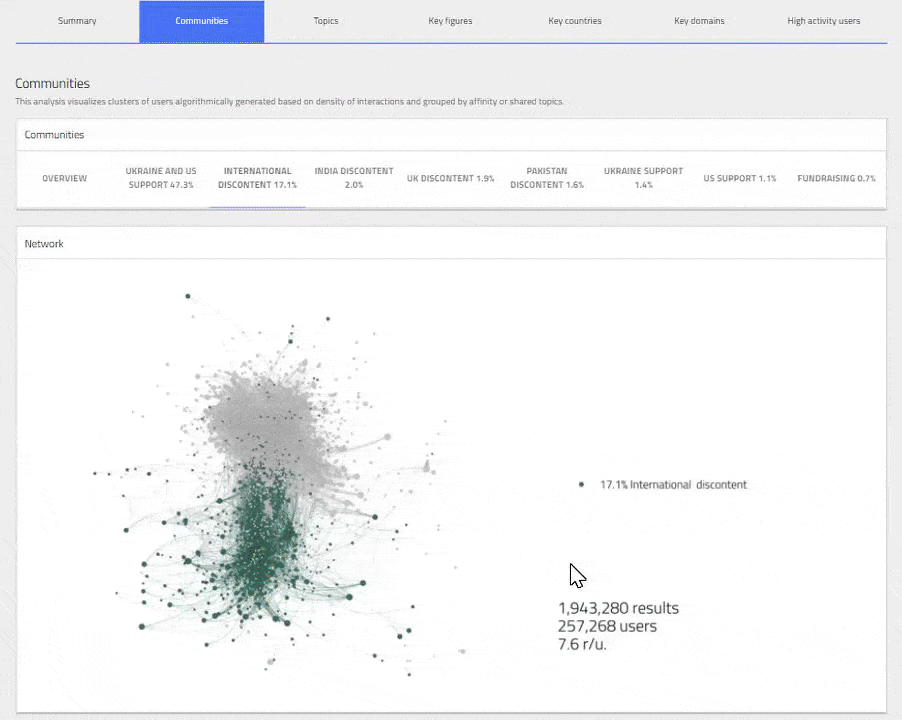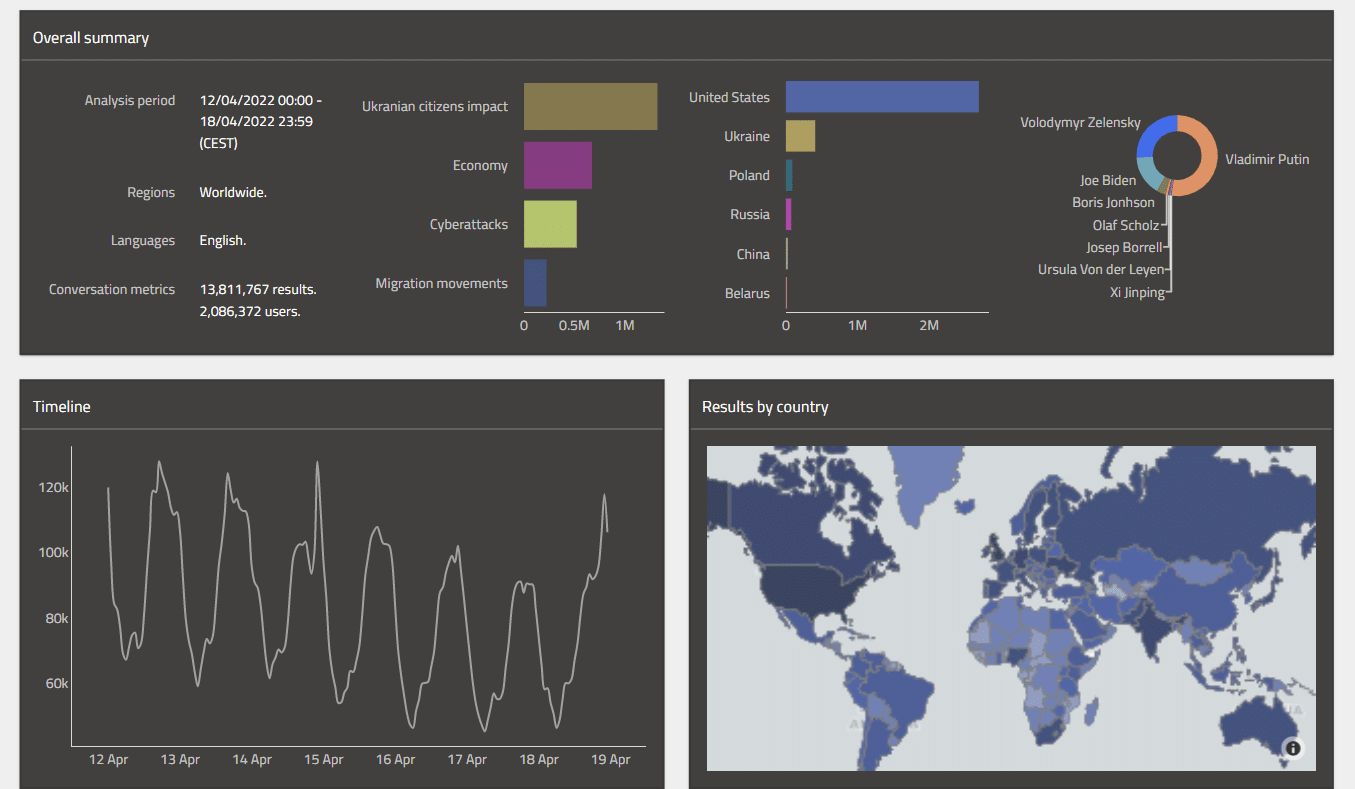To understand the narratives and key players driving the digital conversation, Constella’s team created a custom, proprietary dashboard available through our Dome Platform, visualizing selected dimensions of the digital public conversation pertaining to the Ukraine crisis with the goal of identifying fast-moving global trends emerging from the online conversation. Each week, Constella Intelligence will share notable findings from its dashboard on the Constella Intelligence blog. Below are key insights from April 12th to 18th, 2022, from the digital public conversation related to Ukraine. Over the period analyzed, the dashboard captured 13,811,767 results generated by 2,086,372 users interacting in English.
KEY INSIGHTS – APRIL 12TH TO 18TH, 2022
1. Criticisms of Zelensky emerge and expand, evolving into widely propagated conspiracy theories.
International users expressing media and political discontent (community #2) attack Zelensky—propagating various unsubstantiated or false narratives. A post shared over 5K times (5th most shared in community #2) refers to a video where Zelensky allegedly appears under the influence of alcohol or drugs. Another highly shared post questions what is being done with the aid sent to the Ukraine. Influential pro-Russian profile, Lee Stranahan (@stranahan) questions Zelensky’s alleged personal fortune. Widely shared accusations include Zelensky releasing paramilitary members who are sexual offenders from jail, using child soldiers, maintaining an autocratic regime, and only asking for weapons rather than food or medicine.
2. Retired Swiss military intelligence officer produces a highly influential article challenging predominant NATO and western media narratives.
Sott.net ranks as the 3rd most influential domain in the “International Discontent” community (#2) for their publication of an article by retired Swiss military intelligence officer Jacques Baud titled, ‘Retired Swiss Military-Intelligence Officer: ‘Is it Possible to Actually Know What Has Been And is Going on in Ukraine?’. The long-form article presents several arguments that challenge NATO and western media narratives, invoking Baud’s professional credibility and experience (former public official at the UN & NATO, among other positions) to detail the origins of the conflict, and media bias, among other points. Sott.net as well as re-publisher, The Unz Review, identify as “alternative media,” with a variety of Covid-, social-, and politics-related conspiracy theories and disinformation content identifiable on their websites.
3. Localized geopolitical narratives concerning Russia generate distinct domestic debates. Groups of users engaging in conversations related to the Ukrainian conflict emerge in independent communities in India, Pakistan, Ukraine, the US, and the UK. As the conflict endures, debates related to global narratives concerning the geopolitical situation have become localized. In India (community #3), influencers include members and former members of the armed forces, politicians, activists, and media professionals discussing India’s relationship with Russia. In Pakistan (community #5), the Federal Minister for Human Rights diffuses messages dispelling local conspiracy theories related to Pakistani figures and Russia. A group of users geolocated in the UK (community #4) discuss the cost of war and the implications on the French elections, while the US-driven profile Occupy Democrats (@OccupyDemocrats) gains traction in the conversation through staunch support of Ukraine. The trend here is clear: Domestic conversations produced by local actors and media will become influenced by ongoing global narratives and generate a wide range of debates.
COMMUNITIES – APRIL 12TH TO 18TH, 2022
1. Ukraine and US Support (47.3% of users): Community led by Ukrainian and US journalists and media. Users focus their activity on amplifying Zelensky’s messages, specifically those in which he asks the international community for more support. Meanwhile, users denounce alleged actions by the Russian army against the civilian population, including executions, rapes, and the Bucha massacre.
2. International Discontent (17.1% of users): Community led by anonymous citizens, communicators, and political and human rights activists. Russian profiles are also present, such as the diplomatic delegation in London or the Ministry of Foreign Affairs. Narratives are critical of media coverage of the conflict for not explaining their side of the story. Conversations question Ukraine’s use of international aid funds. Users also attack Zelensky, alluding to a video where he appears under the influence of alcohol or drugs and questioning the origin of his alleged personal fortune. Finally, criticisms emerge regarding aid sent from the US to Ukraine, criticizing the prioritization of funds for war over the domestic needs of Americans.
3. India Discontent (2.0% of users): Main influencers in this community include members and former members of the armed forces, politicians, political activists, and media professionals like journalists, correspondents, and editors. The declarations of Subrahmanyam Jaishankar (Indian foreign minister) are spread, noting that Indian energy purchases from Russia are marginal compared to those of Europe.
4. UK Discontent (1.9% of users): A plurality of issues are addressed, ranging from condemnations of the human cost of the war, the upcoming elections in France, and support for Ukraine regardless of who governs.
5. Pakistan Discontent (1.6% of users): Led by Shireen Mehrunnisa Mazari, Federal Minister for Human Rights, whose protagonistic views are owed to messages questioning conspiracy theories surrounding Imran Khan’s trip to Russia. Mazari also broadcasted a demonstration against the Prime Minister for accusing the United States of being behind his fall because he asked Russia for economic aid.
6. Ukraine Support (1.4% of users): Publications from the Ukrainian government about the sinking of the Russian warship “Moskva” and the request for weapons are published. There is also news from The Spectator Index about Russia’s shipment of S-400 missiles to India and Russia’s ban on Boris Johnson from entering the country.
7. US Support (1.1% of users): Community led by Occupy Democrats’ profile. Their publications stand out, supporting the owner of a Kentucky restaurant who has received criticism for putting the Ukrainian flag in his establishment. Occupy Democrats supports Trump-critical statements of retired Lieutenant Colonel Alexander Vindman and the possible incorporation of Finland into NATO.
8. Fundraising (0.7% of users): Digital campaigns requesting donations to provide financial aid and support to the Ukrainian population.
APPENDIX – APRIL 12TH TO 18TH, 2022
In the first iteration of this dashboard, we captured results related to the following 3 dimensions: Countries, Key Figures, Themes
- Selected countries currently in the dashboard include: The United States, Ukraine, Russia, China, Poland, Belarus
- Selected Key Figures currently in the dashboard include: Vladimir Putin, Volodymyr Zelensky, Joe Biden, Boris Johnson, Ursula Von der Leyen, Josep Borrell, Xi Jinping, Olaf Scholz. Any mentions to these key figures are captured in the dashboard and can be visualized across multiple dimensions of analysis.
- Selected themes currently in the dashboard include: Ukraine Citizens Impact, Economy, Cyberattacks, Migration Movements
Constella's Ukraine dashboard - Community Module Preview

To see our full dashboard in action, Request a Demo with one of our geopolitical intelligence experts.
Read previous week’s findings:





